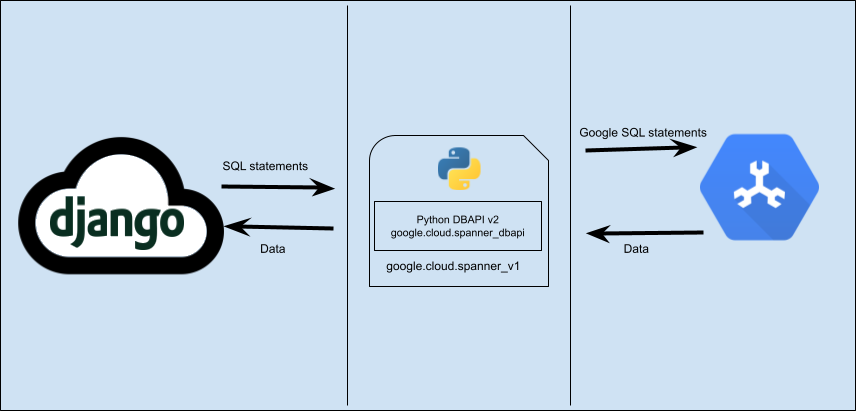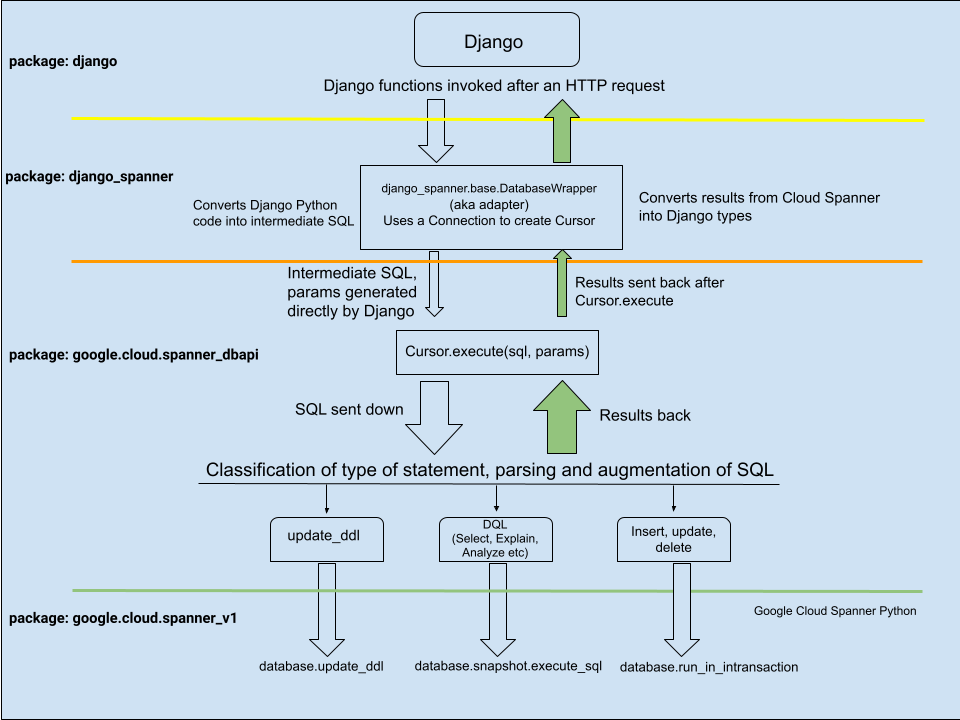Bridge to enable using Django with Spanner.
Project description
Cloud Spanner is the world’s first fully managed relational database service to offer both strong consistency and horizontal scalability for mission-critical online transaction processing (OLTP) applications. With Cloud Spanner you enjoy all the traditional benefits of a relational database; but unlike any other relational database service, Cloud Spanner scales horizontally to hundreds or thousands of servers to handle the biggest transactional workloads.
Quick Start
In order to use this library, you first need to go through the following steps:
This package provides a 3rd-party database backend for using Cloud Spanner with the Django ORM. It uses the Cloud Spanner Python client library under the hood.
Installation
Install this library in a virtualenv using pip. virtualenv is a tool to create isolated Python and Django environments. The basic problem it addresses is one of dependencies and versions, and indirectly permissions.
With virtualenv, it’s possible to install this library without needing system install permissions, and without clashing with the installed system dependencies.
Supported versions
The library supports Django 2.2, and Django 3.2. Both versions are long-term support (LTS) releases for the Django project<https://www.djangoproject.com/download/#supported-versions>_. The minimum required Python version is 3.6.
pip3 install django==3.2Installing the package
To install from PyPI:
pip3 install django-google-spannerTo install from source:
git clone git@github.com:googleapis/python-spanner-django.git
cd python-spanner-django
pip3 install -e .Creating a Cloud Spanner instance and database
If you don’t already have a Cloud Spanner database, or want to start from scratch for a new Django application, you can create a new instance and database using the Google Cloud SDK:
gcloud spanner instances create $INSTANCE --config=regional-us-central1 --description="New Django Instance" --nodes=1
gcloud spanner databases create $DB --instance $INSTANCEConfiguring settings.py
This package provides a Django application named django_spanner. To use the Cloud Spanner database backend, the application needs to installed and configured:
Add django_spanner as the first entry in INSTALLED_APPS:
INSTALLED_APPS = [ 'django_spanner', ... ]Edit the DATABASES setting to point to an existing Cloud Spanner database:
DATABASES = { 'default': { 'ENGINE': 'django_spanner', 'PROJECT': '$PROJECT', 'INSTANCE': '$INSTANCE', 'NAME': '$DATABASE', } }
Set credentials and project environment variables
You’ll need to download a service account JSON key file and point to it using an environment variable:
export GOOGLE_APPLICATION_CREDENTIALS=/path/to/keyfile.json
export GOOGLE_CLOUD_PROJECT=gcloud_projectApply the migrations
Please run:
$ python3 manage.py migrateThat’ll take a while to run. After this you should be able to see the tables and indexes created in your Cloud Spanner console.
Create a Django admin user
First you’ll need to create a user who can login to the admin site. Run the following command:
$ python3 manage.py createsuperuserwhich will then produce a prompt which will allow you to create your super user
Username: admin
Email address: admin@example.com
Password: **********
Password (again): **********
Superuser created successfully.Login as admin
Now, run the server
python3 manage.py runserverThen visit http://127.0.0.1:8000/admin/
Create and register your first model
Please follow the guides in https://docs.djangoproject.com/en/2.2/intro/tutorial02/#creating-models to create and register the model to the Django’s automatically-generated admin site.
How it works
Overall design

Internals

Executing a query
Here is an example of how to add a row for Model Author, save it and later query it using Django
>>> author_kent = Author( first_name="Arthur", last_name="Kent", rating=Decimal("4.1"),)
>>> author_kent.save()
>>> qs1 = Author.objects.all().values("first_name", "last_name")How to contribute
Contributions to this library are always welcome and highly encouraged.
See CONTRIBUTING for more information on how to get started.
Please note that this project is released with a Contributor Code of Conduct. By participating in this project you agree to abide by its terms. See the Code of Conduct for more information.
Limitations
Spanner has certain limitations of its own. The full set of limitations is documented here. It is recommended that you go through that list.
Django spanner has a set of limitations as well, which you can find here.
Project details
Release history Release notifications | RSS feed
Download files
Download the file for your platform. If you're not sure which to choose, learn more about installing packages.
Source Distribution
Built Distribution
Hashes for django-google-spanner-3.0.1.tar.gz
| Algorithm | Hash digest | |
|---|---|---|
| SHA256 | 8fe47740746666eca328e9c3ff3c33084b069643c6cb132c273890f0bce7a232 |
|
| MD5 | 1fe89a51469931211a7eae9a13e07c0c |
|
| BLAKE2b-256 | b4fac6fdf1c059b5ec2da6c8f8d207e4c55d0fe8ce5a5bf499283bf57453475f |
Hashes for django_google_spanner-3.0.1-py3-none-any.whl
| Algorithm | Hash digest | |
|---|---|---|
| SHA256 | ff37f19a5c2eaaa953e6a4ea3cf191c13aeadd9515276aa61cbc1d9e546edf0a |
|
| MD5 | 431d61a1da3ca0e6da7ec8a287a1609f |
|
| BLAKE2b-256 | fa7a90d1bbc2502c25b7245285f3bdbd753f169c139a6fd2a45e033f0cfc06da |















